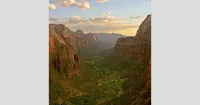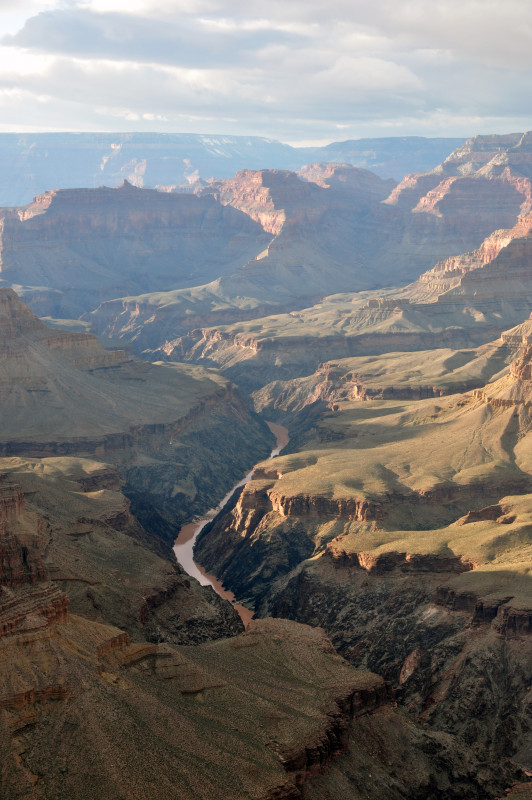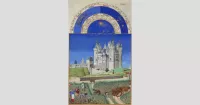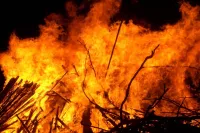Bryce Canyon National Park, situated in southwestern Utah, is renowned for its unique geological formations called hoodoos. These striking red, orange, and white rock pillars are formed by erosion on the edge of the Paunsaugunt Plateau, creating a series of natural amphitheaters, not actually a canyon. Positioned at a high elevation, ranging from 8,000 to 9,000 feet, the park offers spectacular views and is smaller in scale compared to nearby Zion National Park.
13 hours ago : Tragedy and Survival: Couple Falls to Death, Cat Survives Fall in Bryce Canyon
A couple tragically died after falling from a scenic overlook in Bryce Canyon National Park. Incredibly, a cat survived a nearly 400-foot fall during the same incident. Investigation is ongoing.
1916: Public Description in Magazine Articles
In 1916, the scenic areas of Bryce Canyon were first described to the public in magazine articles published by Union Pacific and Santa Fe railroads.
1918: Increased Interest Sparked by Articles
In 1918, more articles helped to spark interest in the scenic wonders of Bryce Canyon's amphitheaters, which were promoted by Forest Supervisor J. W. Humphrey and others.
June 8, 1923: Bryce Canyon National Monument Established
On June 8, 1923, President Warren G. Harding established Bryce Canyon National Monument after receiving a recommendation from National Park Service Director Stephen Mather.
1923: National Monument Designation
In 1923, Bryce Canyon was originally designated as a national monument by President Warren G. Harding.
1923: Process for Transferring Ownership of Land
In 1923, a process led by the Utah Parks Company for transferring ownership of private and state-held land to the federal government started.
1924: Road Construction
In 1924, a road was built on the plateau to provide access to outlooks over the amphitheaters.
1924: Work on Upgrading Protection Status
In 1924, members of the United States Congress started work on upgrading Bryce Canyon's protection status from national monument to national park to establish Utah National Park.
1925: Bryce Canyon Lodge Construction
From 1924 to 1925, Bryce Canyon Lodge was built from local timber and stone.
February 25, 1928: Bryce Canyon National Park Established
On February 25, 1928, Bryce Canyon National Park was officially established after the last of the land was acquired and transferred to the federal government.
1928: National Park Redesignation
In 1928, Bryce Canyon was redesignated as a national park by Congress.
1931: Area Annexation
In 1931, President Herbert Hoover annexed an adjoining area south of the park.
1934: Rim Road Completion
In 1934, Rim Road, a scenic drive, was completed by the Civilian Conservation Corps.
1942: Area Addition
In 1942, an additional 635 acres (257 ha) was added to Bryce Canyon National Park.
September 15, 1950: USS Bryce Canyon Service Start
On September 15, 1950, the USS Bryce Canyon, named for the park, began its service as a supply and repair ship in the U.S. Pacific Fleet.
1956: First Superintendent
In 1956, Bryce Canyon's first superintendent started work; until then, park administration was conducted from Zion National Park.
1961: Bryce Canyon Natural History Association Established
In 1961, the Bryce Canyon Natural History Association (BCNHA) was established as a non-profit organization to support the park's interpretive, educational, and scientific activities.
January 13, 1963: Record Low Temperature
On January 13, 1963, Bryce Canyon National Park recorded a record low temperature of −26 °F (−32 °C).
June 30, 1981: USS Bryce Canyon Service End
On June 30, 1981, the USS Bryce Canyon ended its service as a supply and repair ship in the U.S. Pacific Fleet.
February 6, 1989: Record Low Temperature
On February 6, 1989, Bryce Canyon National Park recorded a record low temperature of −26 °F (−32 °C).
June 2000: In-Park Shuttle System Implemented
In June 2000, the National Park Service (NPS) implemented a voluntary, summer-only, in-park shuttle system in response to increased visitation and traffic congestion.
July 14, 2002: Record High Temperature
On July 14, 2002, Bryce Canyon National Park recorded its highest temperature at 98 °F (37 °C).
2004: Road System Reconstruction
In 2004, reconstruction began on the road system within Bryce Canyon National Park.
2016: Visitor Statistics
In 2016, Zion National Park had nearly 4.3 million visitors and Grand Canyon National Park had almost 6 million visitors.
April 7, 2020: Park Closure due to COVID-19
On April 7, 2020, Bryce Canyon National Park was closed to help prevent the spread of COVID-19.
May 6, 2020: Phased Reopening
On May 6, 2020, a phased reopening of Bryce Canyon National Park started after its closure due to COVID-19.
2023: Visitor Statistics
In 2023, Bryce Canyon received 2,461,269 visitors.
Mentioned in this timeline
The United States of America is a federal republic of...

Zion National Park situated in southwestern Utah showcases a remarkable...

Annexation in international law is the forceful seizure and claim...

The Grand Canyon is a steep canyon carved by the...

September is the ninth month of the year in the...
National parks are protected areas of natural semi-natural or developed...
Trending

24 minutes ago Harvard's credit rating in doubt after Trump targets tax-exempt status post Oct 7.

24 minutes ago Ocean Vuong's life changing interview and noteworthy book releases in May.

24 minutes ago Waltz's Israel conversations angered Trump; Rubio's rise; Waltz's security questions raised.

1 hour ago Jill Sobule, 'I Kissed a Girl' Singer, Tragically Dies in Minneapolis House Fire

1 hour ago Keanu Reeves and Sandra Bullock Reunite for Romantic Thriller at Amazon MGM

1 hour ago Johnny Depp and Penélope Cruz filming thriller in Vilanova i la Geltrú, Spain.
Popular

Pope Francis is the current head of the Catholic Church...

Ronald Reagan the th U S President - was a...

Michael Jordan also known as MJ is an American businessman...

Cristiano Ronaldo often nicknamed CR is a highly decorated Portuguese...

LeBron James nicknamed King James is a professional basketball player...
The Real ID Act of is a US federal law...